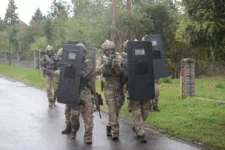There are several types of ballistics shields to choose from in the market. Due to this, it might prove difficult to select the best suited for a particular department, agency or operation team.
However, there are a few aspects that the people in charge of procurement can consider when selecting ballistics shields for the operations team.
The following are some of these essential considerations.
1. Handle System
The most suitable ballistic shield is one with an easy to use and intuitive handle system. The system should also afford the carrier a significant amount of balance when in use. Furthermore, the shield should never lock in the arm/hand, and its design should ideally enable the carrier to use his hand for other uses. The bat-shield designs will give the carrier more use of his arm, unlike the regular rectangular-shaped designs.
Ensure that the manufacturers’ instructions are followed to the letter when it comes to the handle system in order to ensure peak performance of both the shield and the carrier.
2. Speed
The required speed for deployment will also play a big part in the selection of the ballistics shield. It is best to keep an ideal number of units in storage for the different deployment speeds that the different missions may necessitate. For instance, if the team frequently encounters missions where the immediate and quick action is required, then the agency should stock enough shields that are specifically suited for rapid deployment. However, the agency should also store enough shields that can be used in slow action combat missions.
It is also important to point out that the department needs to be able to adequately multi-task the relatively few resources in its possession. This is a less costly method of stocking on gear and equipment, hence, it is imperative that the shields chosen can work well in different speed deployment scenarios.
3. Size
The size of the ballistic shield should take into consideration many factors that include the size of the shield carrier, the type of coverage, the amount of space available in the vehicle, the prevailing conditions of the mission, and the necessary deployment speed.
The best shield size, especially for the first responders, is one that provides adequate mobility for the operant. The size should also be adequate enough to protect them in the areas where their soft body armor cannot reach. This includes areas such as their privates.
It should also not be too big to hamper visibility, and the operant should be able to fire adequately towards the threat and reach his/her intended target.
4. Illumination
Lights on the shields is usually a critical detail in shield selection especially because they will attract the threat’s firepower on to the operant. It is best to have shields with central mounted lights as this will ensure that the assailant is only firing at the operator in the areas that are covered by the shield. Hence, the operator is less likely to get hit by a bullet from the assailant’s gun.
Tencate Advanced offers you the best in ballistic body armor, and here you can find the best ballistics shields that meet the criteria that your agency is searching for. There are a variety of options available here and the professional staff will be able to guide you on which is the perfect choice for your specific team.








